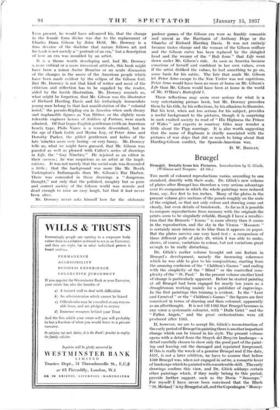Bruegel
TILE merit of coloured reproductions varies, according to one Standard, directly with their scale. Dr. Gliick's new volume of plates after Bruegel has therefore a very serious advantage over its companion in which the whole paintings were reduced from, say, five feet to ten inches. Many of the plates in the present volume give sections of the panels roughly on the scale of the original, so that not only colour and drawing come out clearly, but even details of brushwork. As far as it is possible to compare reproductions from memory _with the originals the prints seem to be singularly reliable, though I have a recollec- tion that the Brussels " Icarus " is more silvery than it seems in the reproduction, and the sky in the Vienna " Massacre " is certainly more intense in its blue than it appears on paper. But the plates survive one very hard test : a comparison of three different pulls of plate 29, which I was able to make, shows, of course, variations in colour, but not variations great
enough to be really disturbing. .
Dr. Gliick's earlier volume brought out one feature in Bruegel's development, namely the increasing coherence which he was able to give to his compositions, starting from the amusing confusion of the ".Children's Games " and ending with the simplicity of the " Blind " or the controlled com- plexity of the " St. Paul." In the present volume another kind of change is particularly apparent. Before he started painting at all Bruegel had been engaged for nearly ten years as a draughtsman working mainly for a publisher of engravings. In the first paintings this training is evident. In the " Lent and Carnival " or the " Children's Games " the figures are first conceived in terms of drawing and then coloured, apparently as an afterthought. It is not till 1562 that Bruegel becomes in any sense a systematic colourist, with " Dulle Griet " and the " Fallen Angels," and the great orchestrations were all produced after 1565.
If, however, we are to accept Dr: Gliick's reconstruction of the early period of Bruegel in painting there is another-important change which can be traced in his style. The present volume opens with a detail from the Stuyck del Bruy ere landscape—a detail carefully chosen to show only the good part ofthe paint- ing and leaving out the damaged .and,repainted foreground. If this is really the wreck of a genuine Bruegel and if-the date, ,1557, is not a later addition, w be
e have to assume that before 1560 Bruegel was, when not engaged-in satire, a romantic lover of landscape which he painted with considerable skill. :Tint early drawings confirm this view, and Dr. Gliick adduers certain other paintings which, if they really belong -ter this period, provide further support, such as the Doris-- ".Seascape." For myself I- haye-. never- been convinced that the Bloch "St. Miehaer-liabyWutzel at all, and the Copenhagen " Money-
ehangers," placed in this group by Dr. Gkiek, must really be dated about 1562 or 1563 and is therefore irrelevant. The mast puzzling painting of this type is the " Icarus " which presumably must belong here, though a comparison of the detail from it (plate 2) with one from the Raudnitz " Haymakers " (plate 27) raises a doubt whether these two paintings can really be separated by eight years. In any case, however, there seems to be strong evidence that up to 1559 Bruegel was alternately a satirist and a romantic, and, in both fields, a skilful technician. After 1559 he seems to have thrown his technical' skill to the winds and to have started on a new line towards that serious and positive realism which produced the great landscapes and peasant scenes of the last five years of his life. Compared with the " Icarus " the " Children's Games " are clumsy but honest, and it seems to have take'n Bruegel some years before he dared once more show his virtuosity. The question remains :. what happened to Bruegel in his private life or to the state of public affairs in Antwerp about 1559 which made him change his approach to painting so fundamentally ? Only something very serious could have driven him from the late mediaeval traditions of Bosch and Patinir and made him break out into an entirely modern realism. It may be that he suddenly found himself capable of expressing the growing national consciousness in the face of Spanish oppression, and that this new spirit entering into him urged him to a new mode of expression.
ANTHONY BLUNT.











































 Previous page
Previous page